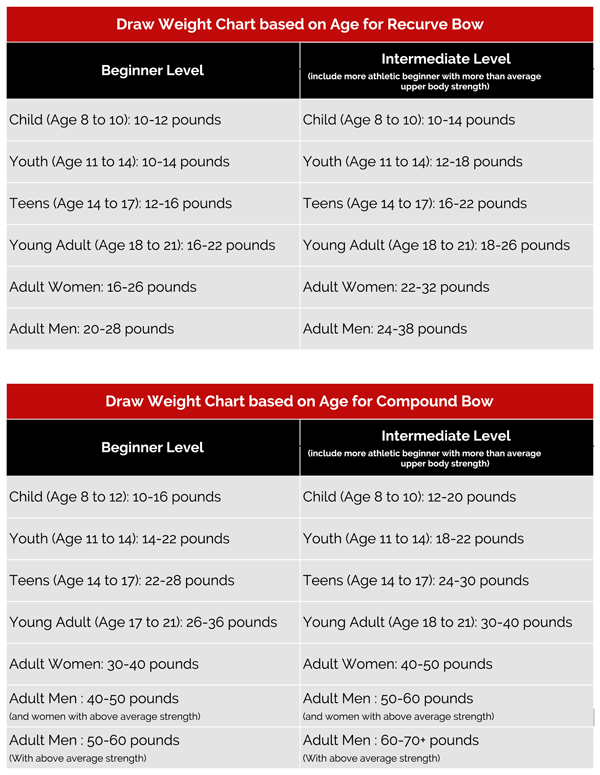Beginning Archery: How to Determine Draw Weight?
How to determine Draw Weight?
Probably the most important aspect for a new archer is to ensure a good experience from the first shot. Draw weight will most likely define your first experience whether it becomes a hobby or a passion.
First of all, everyone has different abilities and capabilities so many factors should be taken into consideration when you want to determine a beginner archer’s draw weight.
But quickly, let see the following suggested draw weight charts below to get the big picture of what it should be like. We say suggested as a starting point because as we mentioned earlier, choosing a draw weight relies on many unique factors.
As you will notice, compound and recurve bows have their own suggested draw weights based on different ages and levels. Let’s have a look.

This chart will definitely help you find a starting draw weight that will be more convenient and better adjusted to yourself while enhancing your first experience as a beginning archer or future hunter.
We do suggest you ask more questions to us or your local archery association if you are not yet sure which draw weight you should pick before buying.
But remember, It is recommended to not being over-bowed by thinking ahead of your actual experience and capabilities in archery, even though your ultimate goal is bow hunting which has minimum poundage requirements to be allowed to do so. It would be better to think about buying another set of limbs with higher poundage for your take-down (2 to 5 lbs more) when you feel more comfortable with your initial draw weight and keep going until you reach the desired poundage.
Compound bows have adjustments (in many cases) which make it more convenient when you are ready to raise up a couple of pounds.
Longbows work a bit differently because the minimum starting draw weight is usually higher than other bows (recurves bows or compound bows). It is often seen as a challenge for archers when they start with longbows. You might have to consider to start with another bow like a starting level recurve bow to get an easier route to obtain a good archery form and then move to a longbow.
Don’t Start Over Bowed.
First of all, it’s very important to understand why starting off over bowed can ruin your progress and furthermore, your love for the sport!
You do not need to stick with the same bow or limbs for several years, you can choose to upgrade when you feel an improvement in your steadiness and strength.
Having in mind to shoot the same bow for many years might have you think of getting a higher draw weight from the start which would automatically lead to over bow yourself right off the bat.
If you are into recurve bow, it might be a good idea to start with a take-down so you can only change the limbs, you won't need to buy a whole new bow when ready to move up in poundage.
If your interest leans towards compound bows, consider choosing a versatile bow with a wide range of draw weight adjustments so you can grow with your bow. The Diamond Infinite Edge Pro and the Diamond Edge SB-1 are great examples of versatility allowing the archer to adjust the settings to his needs.
By selecting a higher draw weight than what you can handle, it would be hard to correct your misalignment and defects and won't be able to tolerate proper training periods. Discomfort and discouragement ahead.
Learn the sport one step at a time and your experience will be enjoyable and your progress will come along. Respect the learning curve!
As you become more proficient you can slowly increase the draw weight. Depending on each archer, you may go up 2 to 5 pounds regarding recurve bows and this amount of weight can go significantly higher with compound bows depending on the let-off. With the let-off, you won't be carrying as much weight when reaching full draw so you can hold still before releasing your arrow for a longer period of time.
With that being said, choosing the proper draw weight for all kinds of archers is a topic that can be touchy. Determining what is right for you depends on your level, strength, condition and stamina as well as what you want to achieve in archery and the type of bow you are using or want to be using. Keep in mind, the more you shoot, the better you'll become!
I hope this article was helpful to you. Please do not hesitate to contact us if you have any questions or write a comment below. Thank you for reading us!
Other suggested posts:
Leave a comment
Comments may require approval prior to appearing.
Comments (0)